William Henry Rogers
- Born: 15 Nov 1832, Hartford CT
- Died: 1896, Hartford CT
General notes:
Silversmith and plater
Events in his life were:
- He appeared on the census in 1850 in Hartford CT. Listed as a clerk in his father's household.
- He appeared on the census in 1860 in Hartford CT. Listed as a jeweler.
- He appeared on the census in 1870 in Hartford CT. Listed without occupation, living in his father's household.
- He worked in 1873-1878 as a silverplater in Hartford CT
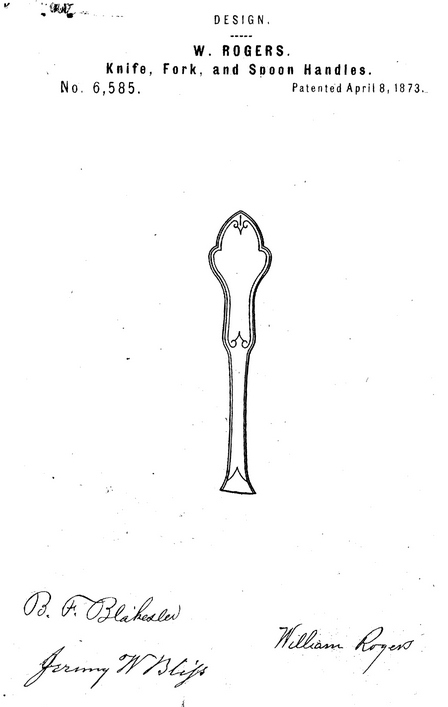
- Patent: 6,585, on 8 Apr 1873. WILLIAM ROGERS, OF HARTFORD, CONNECTICUT, ASSIGNOR TO LUCY J. ROGERS, OF SAME PLACE.
DESIGN FOR KNIFE, FORK, AND SPOON HANDLE.
Specification forming part of Design No. 6,585, dated April 8, 1873 ; application filed March 22, 1873.
To all whom it may concern:
Be it known that I, WILLIAM ROGERS, of the city and county of Hartford and State of Connecticut, have invented or discovered a new and useful Design for Knife, Fork, Spoon Handle, &c., and to enable others skilled in the art to make the same, I will proceed to describe.
In the accompanying drawing is shown the outline, shape, or pattern of the handle. The line just inside of the outline edge of the handle is a bead configuration. Inside of this bead configuration the enlarged portion of the handle is embellished with a second bead and quirks—the whole shape and configuration combined to produce a new and rich design for a handle.
What I claim as my invention is— A design for a handle for knife, fork, spoon, as above shown and described.
William Rogers.
Witnesses:
B. F. Blakeslee
Jeremy W. Bliss
- He worked in 1878-1896 as a silverplater in Hartford CT for SIMPSON, HALL, MILLER &Co.
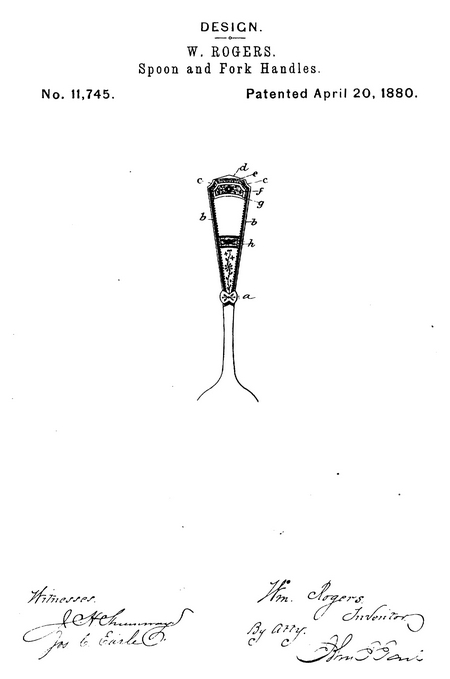
- Patent: 11,745, on 20 Apr 1880. WILLIAM ROGERS, OF WALLINGFORD, CONNECTICUT, ASSIGNOR TO SIMPSON, HALL, MILLER & CO., OF SAME PLACE.
DESIGN FOR SPOON AND FORK HANDLES.
SPECIFICATION forming part of Design No. 11,745, dated April 20, 1880.
Application filed March 3, 1879. Term of patent 3 1/2 years.
To all whom it may concern:
Be it known that I, WM. ROGERS, of Wallingford, in the county of New Haven and State of Connecticut, have invented a new Design for Spoon and Fork Handles; and I do hereby declare the following, when taken in connection with the accompanying drawing and the letters of reference marked thereon, to be a full, clear, and exact description of the same, and which said drawing constitutes part of this specification, and represents in the figure a face view.
This invention relates to a design for the handles of spoons and forks; and it consists in the configuration and ornamentation, as shown in the accompanying illustration.
About midway of the length of the handle is a boss, a. From this point the handle expands, the edges b being straight to the end, then turning abruptly inward in curves c of about a quarter-circle, the upper termination of said curves being joined by two straight lines, d, meeting at au obtuse angle in the center of the end. Following the outlines b and c is a bead formed of full lines and au internal line made of alternate dots and dashes. This bead does not follow the augular tip formed by the lines d, but extends across the tip in an arc of a circle, e, from one of the curves c to the other. At the end of the handle and within this bead is a panel, f, having its upper curve following the curve c of the bead, and its sides corresponding with the shape of the handle, the bottom line of said panel being also curved upward. This panel contains as ornament a central flower with divergent tendrils on a mat ground, and is surrounded by a broad projecting band, g, following its contour. About midway of the upper part or section of the handle a curved-upward segmental panel, h, is placed, containing a central ornament upon a mat ground, and under said segmental panel h is placed a floriated and wavy branch, as shown in the accompanying illustration.
I am aware that it is not new to form a spoon or fork handle with expanding straight sides, as this has been done for at least ten years last past, and do not claim this form, broadly; but
What I claim is—
The herein-described design for spoon and fork handles, consisting of the gradually-expanding straight sides terminating in inward curves c and straight lines d, meeting at the end, and a bead having its upper line, e, curved, with a panel, f, having its upper and lower lines segmental and curved upward, said panel having a depressed mat ground and bright relief ornaments, surrounded by a bright band, g, all together as shown in the accompanying illustration.
Wm. Rogers
Witnesses:
C. H. Barber
C. H. Brown
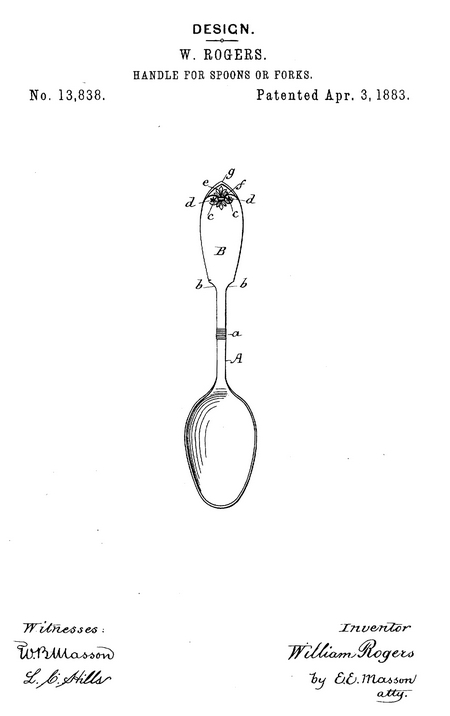
- Patent: 13,838, on 3 Apr 1883. WILLIAM ROGERS, OF HARTFORD, ASSIGNOR TO SIMPSON, HALL, MILLER & CO., OF WALLINGFORD, CONNECTICUT.
DESIGN FOR A HANDLE FOR SPOONS OR FORKS.
SPECIFICATION forming part of Design No. 13,838, dated April 3, 1883.
Application filed March 3, 1883. Term of patent 7 years.
To all whom it may concern :
Be it known that I, WILLIAM ROGERS, a citizen of the United States, residing at Hartford, in the county of Hartford and State of Connecticut, have invented and produced a new and original Design for the Handle of Spoons, Forks, &c., of which the following is a specification, reference being had to the accompanying drawing, forming a part thereof, in which is represented a front view of a spoon having my newly-designed handle.
The invention relates to a design for the handle of spoons, forks, and like articles of table-service; and it consists in the peculiar configuration of the upper part of the handle, in connection with scrolls, rosettes, &c., embossed thereon, and also in a series of transverse corrugations of uniform size upon the handlestem.
To describe the invention more fully, starting from the body of the article, the stem A of the handle is made with substantially parallel sides, and it is provided about half-way of its length with a series of transverse corrugations, a, of uniform size. The stem expands laterally in curves b, of about a quarter of a circle, where it joins the upper part, B, of the handle. This part B is nearly elliptic in form and free of fillets, except adjoining the tip, where there are two scrolls, c, surrounding rosettes d, and between the scrolls is a sheaf of leaves, e, secured by a band, f, and above said sheaf is a fillet, g, inclosing the upper end, as shown in the accompanying illustration.
What I claim is—
1. The herein-described design for articles of table-service, consisting of a handle the stem A of which has substantially parallel sides, and a series of transverse corrugations, a, of uniform size, with the contour of the upper part, B, of the handle of substantially elliptical form, as set forth.
2. The herein-described design, having the contour of the stem A terminating in quartercircles b, the substantially elliptical upper part, B, having a plain surface free of fillets except, at the tip end, said tip having an ornament composed of two rosettes surrounded by scrolls c, and between said scrolls a sheaf consisting of several feaves secured together by a band, substantially as shown and described.
William Rogers
Witnesses:
C. H. Brown
I. A. Martin
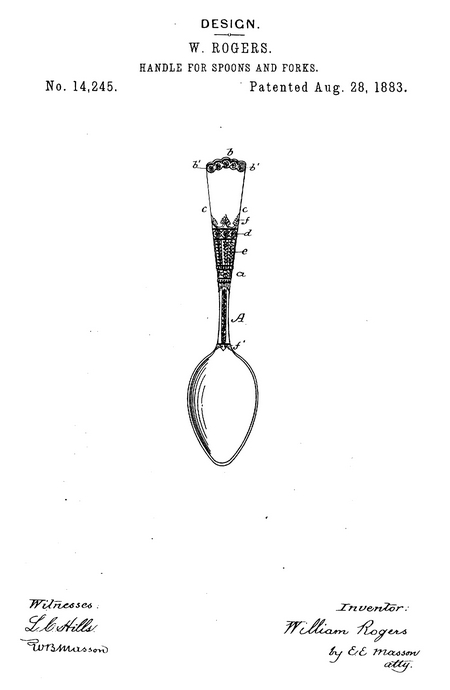
- Patent: 14,245, on 28 Aug 1883. WILLIAM ROGERS, OF HARTFORD, ASSIGNOR TO SIMPSON. HALL, MILLER & CO., OF WALLINGFORD, CONNECTICUT.
DESIGN FOR A HANDLE FOR SPOONS AND FORKS.
SPECIFICATION forming part of Design No. 14,245, dated August 28, 1883.
Application filed July 13, 1883. Term of patent 7 years.
To all whom it may concern:
Be it known that I, WILLIAM ROGERS, a citizen of the United States, residing at Hartford, in the county of Hartford and State of Connecticut, have invented and produced a new and original Design for the Handles of Spoons, Forks, &c., of which the following is a specification, reference being had to the accompanying drawings, forming apart thereof, in which is represented a front view of a spoon having my newly-designed handle.
The invention relates to a design for the handles of spoons, forks, and like articles of tableservice; and it consists in the peculiar configuration of the upper part of the handle, in connection with circles inclosing rosettes embossed thereon, and also in a series of twin leaves strung together and arranged in three rows upon the handle-stem.
To describe the invention more fully, starting from the bowl of the spoon, or from the body of the article, the lower portion, A, of the stem of the handle has its sides slightly concave until the boss a is reached, and from that point to the tip b the sides c c are straight but divergent lines. Between these sides, and about one-third the distance between the boss a and tip b, there is a transverse panel containing three rosettes, d, inclosed in circles, and between these rosettes and the boss a there is a panel, e, containing twin leaves strung together and arranged in three rows lengthwise of said panel. The tip b of the handle is formed with five scallops, each containing a circle, or scrolls resembling a circle, and each circle a rosette, b'. Immediately above the panel containing three rosettes, d, there is embossed upon the handle a central scroll and two halfscrolls, f, and similar scrolls, f, are embossed upon the handle-stem adjoining the bowl, and between the scrolls f and the boss a the stem is provided with a longitudinal row of twin leaves intermixed with small rosettes, all as shown in the accompanying illustration.
What I claim is—
The design herein described and shown.
William Rogers
Witnesses:
C. H. Brown
J. A. Martin
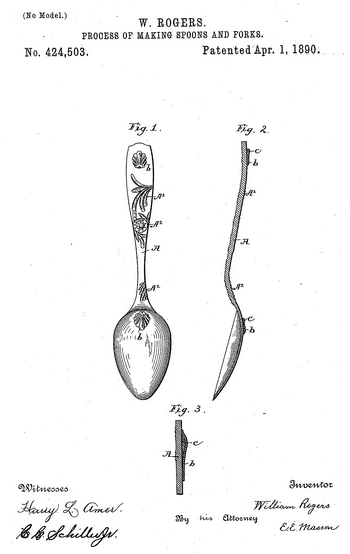
- He was issued patent number 424,503 on 1 Apr 1890
WILLIAM ROGERS, OF HARTFORD, CONNECTICUT.
PROCESS OF MAKING SPOONS AND FORKS.
SPECIFICATION forming part of Letters Patent No. 424,503, dated April 1, 1890.
Application filed December 30, 1889.
To all whom it may concern:
Be it known that I, WILLIAM ROGERS, a citizen of the United-States, residing at Hartford, in the county of Hartford, State of Connecticut, have invented certain new and useful Improvements in the Process of Making Spoons and Forks, of which the following is a specification, reference being had therein to the accompanying drawings.
The object of my invention is to produce a simple process to greatly increase the lasting properties of plated silver-ware, and at the same time ornament its surface with, embossed thin sheet-metal silver, presenting a series of convexities on one side and concavities on the opposite side, packing and sustaining said embossed silver, and securing it to said silver-ware. I attain these objects as shown in the accompanying drawings, in which—
Figure 1 is a rear view of a spoon provided at two points with an embossed sheet-metal patch prepared and secured thereto in accordance with my process. Fig. 2 is a vertical section of the same; and Fig. 3 is a longitudinal section, on a larger scale, of the embossed sheet-metal patch secured to a portion of the spoon.
It is well known that plated silver-ware that is much in use, particularly spoons and forks, will rapidly have the silver-plating worn out and be thus defaced at the points upon which they rest on a table or other surface, these points where the greatest amount of friction occurs being at the bend of the bowl (of spoon) and at the bend adjacent to the tip of the handle. To remedy this defect and at the same time improve the appearance of inexpensive metal ware, I cut, bend, and press a blank, for example, of a spoon of suitable size and thickness, as shown at A, either plain or with suitable designs A2 thereon, said designs being generally in intaglio in the matrix or die of the press to bring them in relief upon the article subjected to pressure. I also cut out of thin sheet-silver small patches, which I place in a press between suitably embossed or ornamental dies and subject them to pressure, so that when removed from said press the thin silver patches b present a series of convexities on one side and concavities on the opposite side; and, as said embossed silver patches are very thin, I prefer to fill their concavities on one side with a soft metal, as solder c, and, with said side laid against the under side of the bowl and handle at the points exposed, I secure them, preferably, with silver solder or with soft solder run around its edge, although it may be secured with one or more rivets. The embossed patch can be added to the spoon-blank either before said blank has been plated or after it has been subjected to that operation.
Having now fully described my invention, I claim—
1. The process of making spoons and forks, which consists in stamping the blank, bending, and concaving the same, also stamping and embossing thin sheet-metal silver with a design presenting a series of convexities on one side and concavities on the opposite side, filling said concavities with solder and attaching said embossed sheet metal to the body of the spoon or fork, substantially as and for the purpose described.
2. The process of making spoons, which consists in stamping the blank, bending, concaving, and embossing the same, also stamping and embossing thin patches of sheetmetal silver with a design representing a series of convexities on one side and concavities on the opposite side, and soldering said embossed sheet-silver patch of metal to the body of the spoon, substantially as described. In testimony whereof I affix my signature in presence of two witnesses.
William Rogers
Witnesses:
Louis Gundlach, Jr.
Ernest A. Brigham
|









